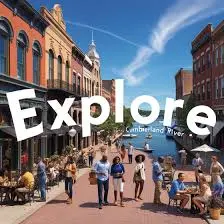Exploring Gay Street and Cumberland River: A Comprehensive Guide to Their History, Culture, and Recent Developments

Gay Street and Cumberland River are two prominent landmarks that define the essence of their respective locales. Gay Street, with its historic charm and cultural significance, stands as a testament to the rich heritage of Knoxville, Tennessee. Meanwhile, the Cumberland River, flowing through Nashville, Tennessee, plays a crucial role in the city’s infrastructure and urban development. This comprehensive guide delves into the historical context, current status, and recent developments of these two important locations.
II. Gay Street: A Historical and Cultural Hub
H2: Historical Background of Gay Street
H3: Early Development and Key Milestones
gay street and cumberland river, located in the heart of Knoxville, is renowned for its historical significance and vibrant cultural scene. The street’s origins date back to the early 19th century when Knoxville was established as a key city in Tennessee. Initially, Gay Street was a hub for trade and commerce, with many of its early buildings serving as essential business establishments.
By the late 1800s, Gay Street had evolved into a bustling center of activity, hosting various shops, theaters, and social venues. Notable structures from this era include the Bijou Theatre, which opened in 1909, and the historic J.C. Penney building, reflecting the architectural style of the early 20th century.
H3: Notable Events and Figures
Throughout its history, Gay Street has been the backdrop for numerous significant events. For instance, the street played a pivotal role during the Civil Rights Movement, serving as a site for rallies and demonstrations advocating for equality and justice.
Several prominent figures have also left their mark on Gay Street. Among them is Charles McClung, an early settler whose contributions to Knoxville’s development were instrumental. Today, Gay Street continues to honor its historical roots through various preservation efforts and cultural events.
H2: Current Status and Significance
H3: Popular Businesses and Attractions
Today, Gay Street is a vibrant district known for its eclectic mix of businesses and attractions. From charming boutiques to trendy restaurants, the street offers something for everyone. Notable establishments include the Knoxville Museum of Art and the historic Market Square, which hosts a variety of events throughout the year.
The revitalization of Gay Street in recent decades has transformed it into a cultural hotspot, attracting both locals and tourists. The annual Dogwood Arts Festival, held on Gay Street, showcases local talent and celebrates the region’s artistic heritage.
H3: Impact on Local Culture and Economy
Gay Street’s significance extends beyond its cultural appeal; it also plays a crucial role in Knoxville’s economy. The street’s thriving commercial sector contributes to job creation and local revenue. Furthermore, the cultural events and festivals hosted on Gay Street foster community engagement and enhance the quality of life for residents.
III. Cumberland River: Vital Waterway and Urban Development
H2: Historical Context of Cumberland River
H3: Initial Exploration and Use
The Cumberland River, which flows through Nashville, Tennessee, has been a vital waterway since the city’s founding. Early explorers and settlers utilized the river for transportation and trade, establishing it as a crucial economic artery for the region.
By the 19th century, the Cumberland River had become a significant transportation route for goods and passengers. The development of river ports and docks along the river facilitated commerce and contributed to Nashville’s growth.
H3: Major Historical Events and Developments
The Cumberland River has witnessed several major historical events, including the Civil War. During this period, the river served as a strategic location for troop movements and supply routes. The construction of the Cumberland River Bridge in 1909 marked a significant engineering achievement and further integrated the river into Nashville’s infrastructure.
H2: Current Infrastructure and Urban Impact
H3: Recent Upgrades and Improvements
In recent years, significant investments have been made to enhance the Cumberland River’s infrastructure. One notable development is the installation of temporary fencing along the river, aimed at improving safety and mitigating potential hazards. This measure addresses concerns related to pedestrian safety and riverbank stability.
According to WKRN, the temporary fencing project is a part of a broader initiative to enhance the riverfront area. The project, which involves installing over 2,000 feet of fencing, is estimated to cost approximately $1.5 million. The new fencing is designed to provide better security and prevent unauthorized access to critical areas along the river.
H3: Role in Local Safety and Urban Planning
The Cumberland River’s role in Nashville’s urban planning is significant. The riverfront area is a focal point for redevelopment projects, including parks and recreational facilities. The ongoing improvements aim to create a more accessible and attractive environment for residents and visitors.
Recent safety measures, such as the temporary fencing, are part of a comprehensive strategy to address concerns related to riverbank erosion and public safety. The city’s planning authorities are working closely with community stakeholders to ensure that future developments align with the needs and preferences of local residents.
IV. Recent Developments and News
H2: Temporary Fencing Along Cumberland River
H3: Purpose and Expected Impact
The temporary fencing installed along the Cumberland River is a response to growing concerns about safety and riverbank stability. According to WSMV, the fencing is intended to prevent unauthorized access to sensitive areas and enhance overall safety for pedestrians and cyclists.
The project, which began in early September 2024, is expected to address several key issues, including erosion control and flood management. The fencing is designed to be both functional and aesthetically pleasing, integrating seamlessly with the existing riverfront landscape.
H3: Stakeholders and Authorities Involved
The temporary fencing project involves collaboration between various stakeholders, including the City of Nashville, the Nashville Department of Public Works, and local community organizations. These entities are working together to ensure that the project meets safety standards and addresses the needs of the community.
Public feedback has been largely positive, with many residents expressing support for the improvements. The project is part of a larger effort to enhance the riverfront area and promote sustainable urban development.
H2: Key Figures and Statistics
H3: Cost and Extent of the Temporary Fencing
The temporary fencing project is estimated to cost approximately $1.5 million. The fencing covers over 2,000 feet of riverfront area, with sections strategically placed to address safety concerns and prevent unauthorized access. The installation process is expected to be completed by late 2024.
H3: Safety Improvements and Public Responses
The temporary fencing is anticipated to improve safety for pedestrians and cyclists along the riverfront. Local officials have reported a decrease in safety incidents since the installation of the fencing. Community feedback has been largely positive, with residents noting the enhanced security and improved aesthetics of the riverfront area.
V. Comparison of Sources
H2: Analysis of Content from Various Sources

H3: Medium Article on Gay Street and Cumberland River
The Medium article provides a detailed overview of Gay Street and its historical significance, focusing on key events and figures. However, it lacks in-depth coverage of recent developments and their impact on the local community.
H3: Knoxville Lost and Found on Gay Street’s 700 Block
This source offers a historical perspective on the 700 Block of Gay Street, highlighting its evolution over time. While informative, it does not address the current status or recent changes in the area.
H3: WKRN and WSMV News on Cumberland River Fencing
WKRN and WSMV provide valuable updates on the temporary fencing project along the Cumberland River. Their coverage includes details about the project’s scope, cost, and expected benefits. However, they focus primarily on the immediate impact rather than the broader historical context.
H3: WHNT Report on Missing Student and Cumberland River
The WHNT report addresses a specific incident involving a missing student and the Cumberland River. While it provides relevant information about the river’s role in the investigation, it does not offer a comprehensive overview of the river’s historical and current significance.
VI. Conclusion
In summary, Gay Street and Cumberland River are two iconic landmarks with rich histories and significant roles in their respective cities. Gay Street’s historical charm and cultural vibrancy make it a key part of Knoxville’s identity, while the Cumberland River’s recent improvements highlight its importance in Nashville’s urban development.


